On the surface, walking, running, and hiking shoes may all appear to serve the same purpose; to protect your feet. However, upon closer inspection, the differences in their construction and design become apparent – each tailored distinctly to cater for the specific demands of the activity they are intended for.
The unique characteristics of these footwear types not only enhance performance but also play a pivotal role in preventing injuries. Consequently, understanding these variations is crucial for anyone keen on optimizing their outdoor experiences, whether it's a leisurely walk, a brisk run, or a challenging hike.
As we navigate through the intricacies of these shoe types, you'll be better equipped to make an informed decision based on your specific needs and preferences.
Key Takeaways
- Walking shoes prioritize comfort and alignment, while running shoes focus on speed and agility, and hiking shoes offer support and protection.
- Walking shoes have cushioned heel and midsole, running shoes have flexible and lighter soles, and hiking shoes have greater grip and traction.
- Walking shoes are suitable for regular walks and flat trails, running shoes for high-impact running, and hiking shoes for rugged terrains.
- Each type of shoe is designed for specific activities and has distinct features tailored to the needs of the wearer.
Understanding Walking Shoes
Delving into the specifics of walking shoes, these footwear options are designed with a cushioned heel and midsole, offering comfort for prolonged walks. They also feature a lightweight construction with breathable upper materials to reduce foot fatigue. Choose the Right pair of shoes for regular walking, as it can significantly impact your personal comfort.
Walking shoes are designed to be comfortable and functional. They prioritize lightweight construction and a rocker-style bottom. The design of the shoe is strategic, aimed at providing the wearer with a smooth and natural gait during regular walks.
The right pair of shoes for walking should be chosen with care. Personal comfort should not be compromised. Remember, the right footgear can make a significant difference in your regular walking routine. It can reduce the risk of injury, alleviate foot pain, and promote overall foot health.
These shoes are not just for the elderly or those with foot problems. They are for anyone who values comfort, health, and the joy of walking. So, when you're out shopping for footwear, consider the benefits of a well-designed walking shoe. It's an investment in comfort, health, and happiness.
Exploring Running Shoes
What makes running shoes distinct from the other types of footwear we've discussed?
The primary characteristic that sets these shoes apart is the way running shoes are designed. Unlike shoes for hiking, which focus on support and durability, running shoes prioritize speed and agility. Running shoes are specifically designed with lightweight materials to reduce foot fatigue and facilitate regular running.
Popular shoe brands invest in research and development to engineer running shoes with lightweight construction without compromising on durability and comfort. The shoe soles are constructed to provide optimal traction for running on various surfaces, while also offering the necessary cushioning to absorb impact, thus protecting the feet during high-intensity running.
Running shoes also have a higher heel drop to support the forward motion, which is a crucial aspect of running. The upper part of these shoes is typically made of breathable material for ventilation, keeping the feet dry and comfortable.
Insights Into Hiking Boots
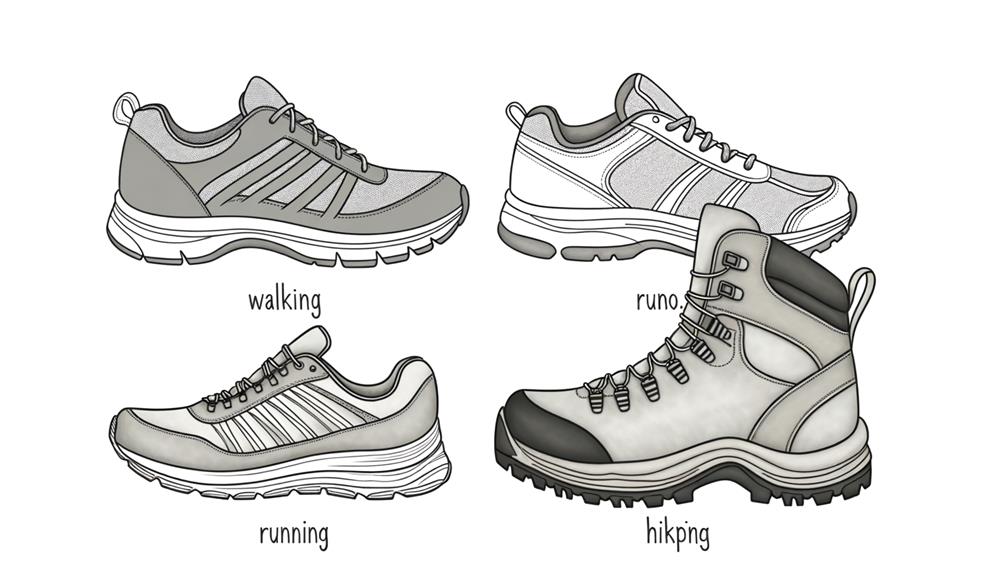
Hiking boots, by design, incorporate features that cater to the demands of rugged terrains and heavy loads. These features include superior grip, durable construction, and water-resistant capabilities, all of which contribute to a hiker's safety and comfort.
The process of choosing the right pair, however, requires careful consideration of various factors such as personal comfort, intended use, and individual foot shape.
Hiking Boots Features
For outdoor enthusiasts venturing into rugged terrain, the choice of footwear, particularly hiking boots, is of paramount importance due to their distinctive features, robust design, and suitability to withstand heavy loads.
Traditional hiking boots are footwear specifically designed with a higher ankle for support and protection, underpinning stability on intense hikes. Hiking boots features include a substantial midsole, providing durability and comfort, even under heavy loads.
The construction and materials of these boots, often water-resistant or waterproof, are designed to withstand varying weather conditions and terrains.
The choice between hiking boots and shoes often comes down to the user's preference for ankle support and protection level. Ultimately, hiking boots offer a combination of support, protection, and durability, making them an ideal choice for outdoor adventurers.
Choosing the Right Pair
Delving into the realm of outdoor footwear, it's crucial to discern the key differences between hiking and walking shoes to ensure you select the right pair for your adventuring needs. The type of shoe depends on both the terrain and your personal preference. While walking shoes are designed for comfort and alignment on well-maintained trails, hiking shoes provide better support and protection on intense hikes. Here's a quick comparison:
| Walking Shoes | Hiking Shoes | |
|---|---|---|
| Designed for | Flat trails | Hills and mountains |
| Key Features | Cushioned heel, Lightweight construction | Greater grip, Durable construction |
| Material | Breathable upper materials | Water-resistant or waterproof |
| Purpose | Comfort and alignment | Support and protection |
In essence, the right shoe should work with you, enhancing your natural stride and providing support where needed. Remember, choosing hiking boots or walking shoes is about finding what works for you.
Comparison: Walking Vs Running Shoes
When considering the differences between walking and running shoes, it's crucial to note that each is constructed with a specific purpose in mind, offering distinct features tailored to the needs of the wearer during their respective activities.
Walking Boots are designed specifically to provide greater comfort over long distances. They typically feature a cushioned heel and midsole, a firm heel counter for stability, and a rocker-style bottom that supports the natural walking motion, making them a good option for those who prefer leisurely strolls or long, scenic hikes.
Running shoes, on the other hand, are lighter and built for speed and agility. They prioritize shock absorption, flexibility, and breathability to accommodate the high impact and quicker pace of running. These shoes typically have a flexible and lighter sole, designed to encourage swift movements. Despite their lightweight construction, they provide effective traction and stability for a forward motion.
Whether you're walking to keep your feet warm and comfortable or running long distances, selecting the right shoe can enhance your experience. Both types have comfort features, but each is uniquely suited to the demands of walking or running.
Comparison: Running Vs Hiking Shoes
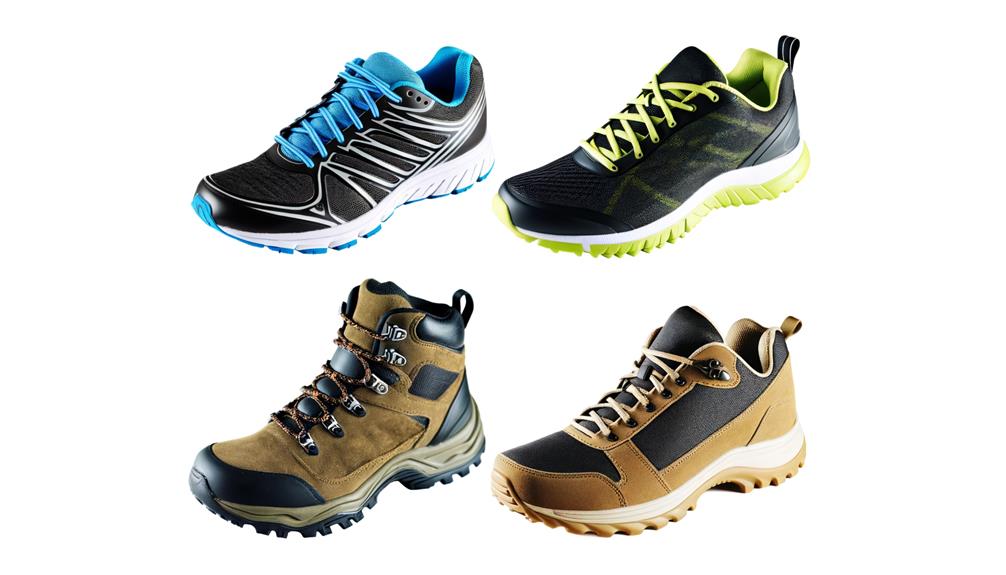
Drawing a comparison between running and hiking shoes, it's imperative to understand that each of these footwear styles is engineered to handle different types of terrain and physical demands.
- Shoes vs Hiking: When considering trail running shoes vs hiking shoes, it is worth noting that running shoes are designed for light, nimble movement on well-maintained trails.
- *Hiking shoes*, on the other hand, offer stability, support and protection for rugged terrains. These shoes are heavier and are designed with durable construction and a sole offering greater grip and traction. They typically feature water-resistant or waterproof materials and speed lacing hooks.
- *Running shoes* prioritize cushioning, lightweight construction, and a rocker-style bottom. They offer comfort and alignment, with breathable upper materials and a cushioned heel and midsole.
Choosing between hiking shoes and running shoes depends on the terrain and physical demands of the activity. Hiking shoes are designed to handle hills, mountains, and slippery surfaces, while running shoes are suitable for flat trails. Recognizing these differences in hiking shoes and hiking boots can help individuals choose the right footwear to ensure optimal performance, comfort, and safety.
Terrain, Environment, and Footwear
Taking into account the crucial differences between hiking and running shoes, it becomes increasingly apparent that the choice of footwear is significantly influenced by the specific terrain and environmental conditions one anticipates to encounter. Hiking shoes are designed with the rigors of hills, mountains, and slippery surfaces in mind. They provide better support and protection on intense hikes, with features like reinforced toe caps and ankle support. Moreover, they are water-resistant or waterproof, which makes them ideal for wear in varying terrain and weather conditions.
On the other hand, walking shoes are crafted for well-maintained and flat trails. These shoes prioritize comfort and alignment, and their breathable upper materials reduce foot fatigue.
For those desiring a middle ground, hybrid-style hiking shoes may be a suitable choice, as they can handle a moderate overlap of terrains.
Trail running shoes, built for light and nimble movement, offer breathability for maintaining a good pace and are suitable for specific landscapes or terrains.
Ultimately, whether one chooses hiking boots or shoes, it's essential to consider the types of terrain one will traverse.
Choosing the Perfect Activity Shoe
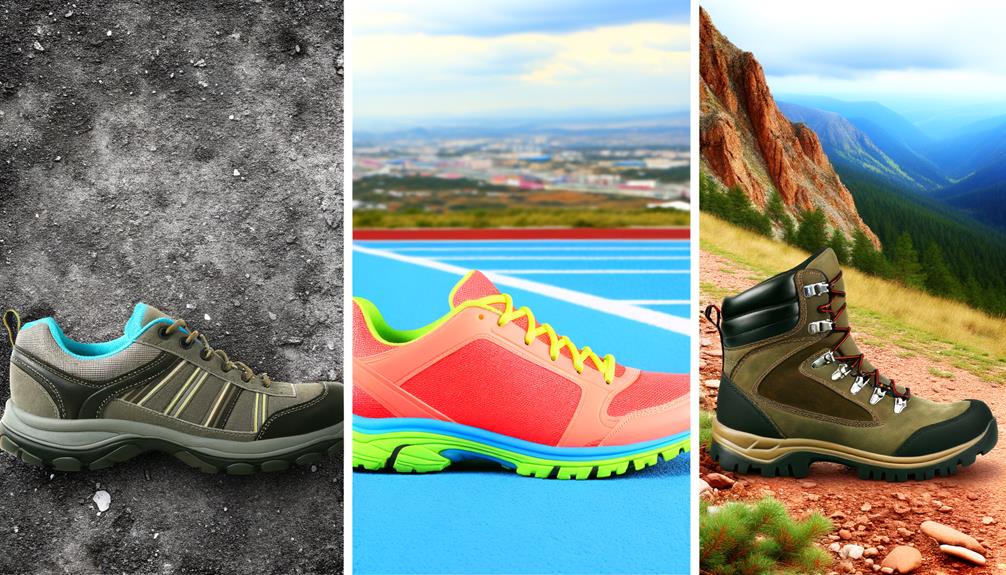
In the realm of outdoor activities, selecting the perfect shoe largely hinges on the specific type of activity, the anticipated terrain, and individual comfort preferences. This process of choosing the perfect activity shoe can be simplified by understanding the unique features each shoe type offers.
Here are some critical points to consider:
- Trail Shoes:
- Designed to keep your feet comfortable and secure on uneven terrain
- Offer support and traction with their deep tread
- Hiking Shoes:
- Typically heavier than trail shoes, offering greater ankle support
- Often feature a waterproof membrane, ensuring the shoes are waterproof
When it comes to walking or hiking, it is essential to know that hiking shoes are typically designed for more demanding terrain and conditions. They not only offer superior ankle support but are also constructed with a waterproof membrane designed to keep your feet dry in wet conditions. On the other hand, trail shoes offer the advantage of a deep tread for better traction on slippery or uneven surfaces.
In essence, your decision should balance your activity's demands with your personal comfort and safety needs.
Frequently Asked Questions
Is It OK to Use Hiking Shoes for Walking?
Hiking shoes, designed for durability and outsole grip, can be used for walking, particularly in rugged terrains. However, for long-distance walks on flat terrains, the lightweight and versatile design of walking shoes may be more comfortable.
Are Running Shoes or Hiking Shoes Better for Walking?
For walking, both comfort and support are essential. Walking shoes offer superior comfort, breathability, and are generally lighter. However, hiking shoes provide durability, tread utility, and greater foot support, beneficial for uneven terrains and longer walks.
Is It OK to Wear Running Shoes for Hiking?
Running shoes may suffice for light, even terrains, but for diverse terrains, hiking shoes provide better durability, ankle support, tread patterns, foot protection, and water resistance, ensuring comfort and versatility despite being heavier.
What Type of Shoe Is Best for Walking?
The best shoes for walking prioritize comfort factors, orthopedic benefits, and durability. They feature advanced technology for cushioning, lightweight materials, and designs suited for various walking terrains, factoring in seasonal variations and fashion trends.
Conclusion
In conclusion, footwear plays a pivotal role in performance and protection during physical activities.
Walking, running, and hiking shoes, each tailored for their respective terrains and activities, could be likened to tools in a toolbox, each meticulously designed for a specific task.
Choosing the right shoe is paramount to ensuring optimal comfort, alignment, and grip, ultimately contributing to a safe and fulfilling experience during walks, runs, or hikes.

With years of extensive experience, I specialize in evaluating waterproof hiking shoe options across various brands. My goal is to offer valuable insights and recommendations, enhancing your hiking experience with tips and suggestions for a more adventurous and comfortable journey.

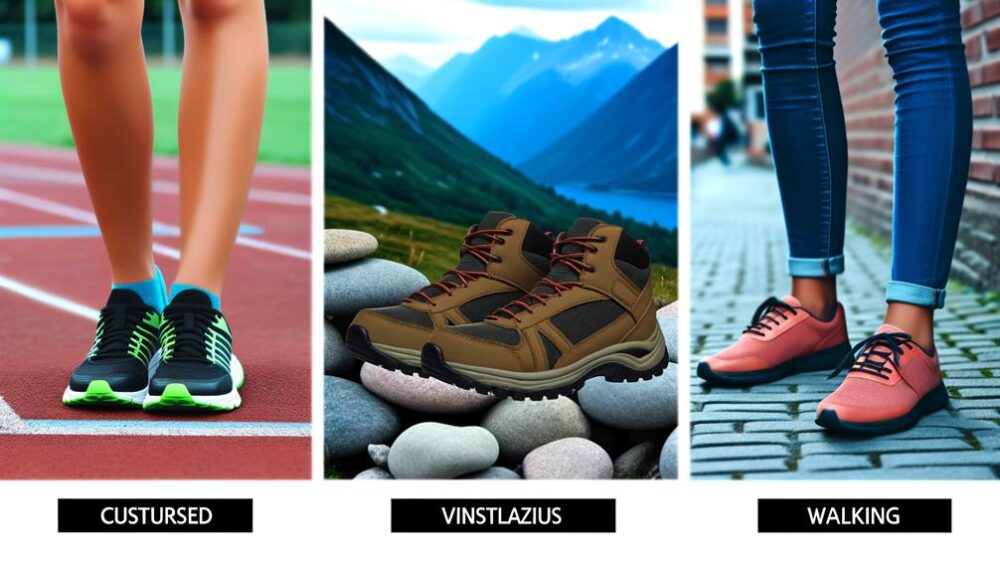
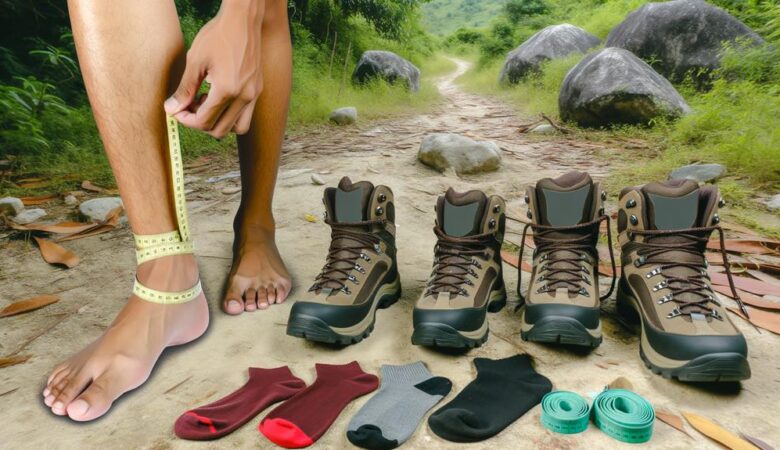
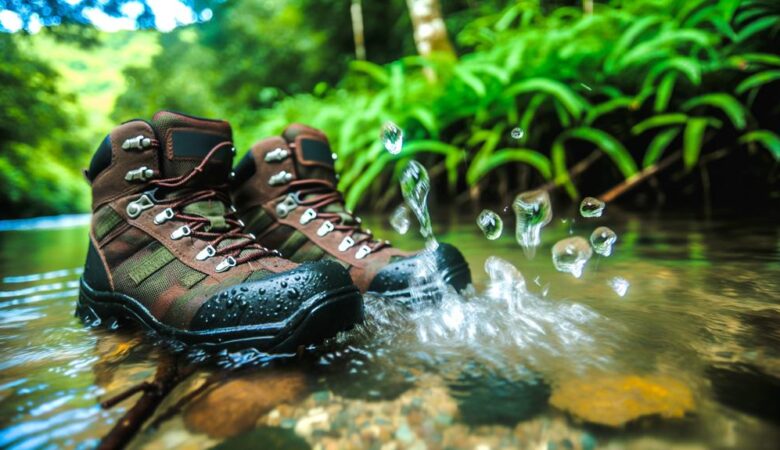
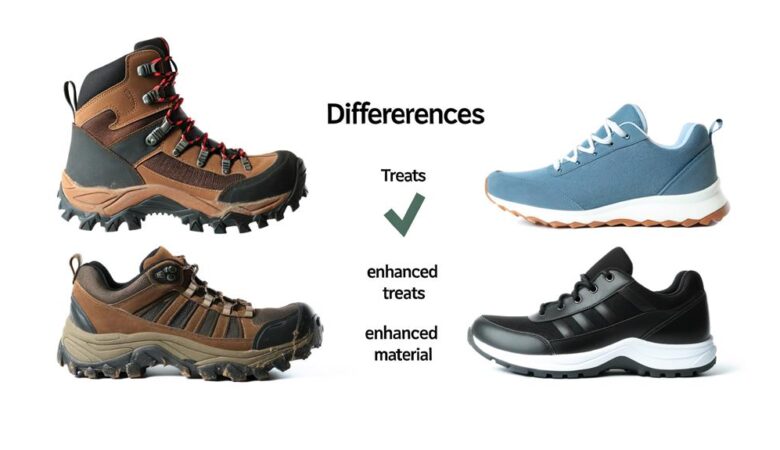
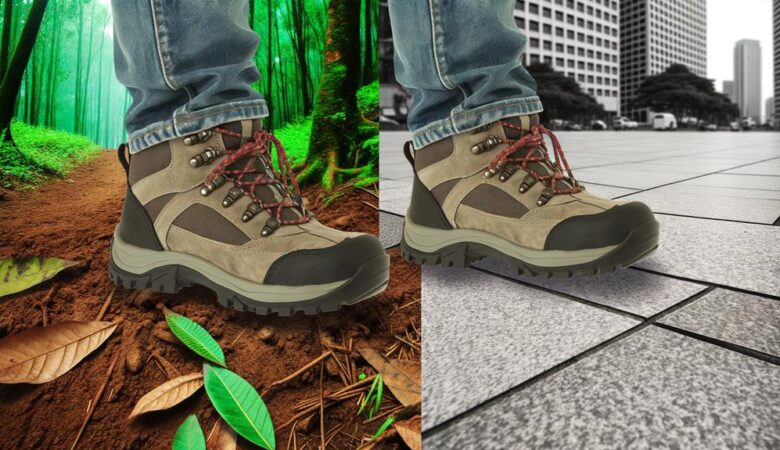
Leave a Reply